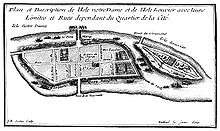Île Louviers

The Île Louviers, also known as the Île aux Javiaux, was an island in the Seine in Paris, France, that was attached to the bank in the nineteenth century.
Geography
The island was situated in the river slightly upstream of the Île Saint-Louis. In 1408 the island belonged to the prévôt des marchands Nicolas de Louviers, whose name remained attached to it to the end. It was a low-lying ait in the river, used for pasturage as it was prone to flooding. The city of Paris purchased it in 1700 and let it out to timber merchants, whose supplies were floated downstream. As late as 1742 it was still scarcely inhabited (see the map of 1742 as illustration).
A three-arched bridge, the Pont de Grammont, connecting it to Quai St-Bernard across the backwater called the bras de Grammont, was under construction in 1836, according to Galignani's New Paris Guide, but in 1847 the narrow space separating it from the Right Bank was filled in and joined to Quai Morland. During the Revolution of 1848 the new ground was temporarily used for an encampment of the army.
References
- Théophile Lavallée, Histoire de Paris depuis le temps des Gaulois jusqu'à nos jours, 2e ed. 1857, vol. II, chap. 2, p. 8
Coordinates: 48°50′56″N 2°21′47″E / 48.84889°N 2.36306°E
| Wikimedia Commons has media related to Île Louviers. |